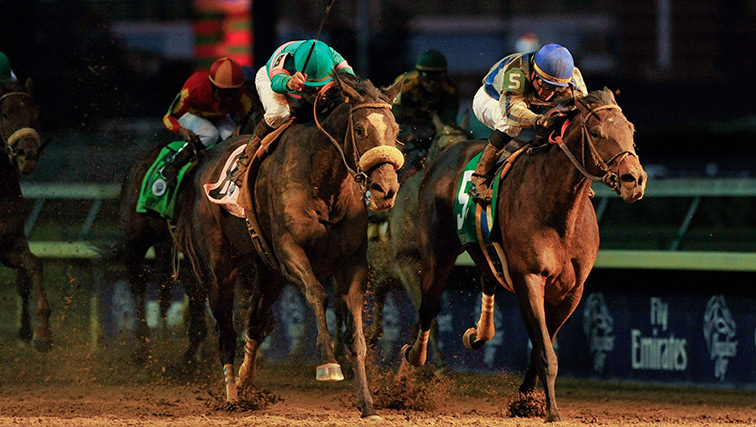Catching Up With Blame

Blame's most famous race was his last when he defeated Zenyatta in the 2010 Breeders' Cup Classic (Photos courtesy of Eclipse Sportswire).
When Blame entered the 2010 Breeder’s Cup Classic, it was the end of a dominant 4-year-old season.
The Claiborne Farm- and Adele Dilschneider-homebred had spent 2010 beating up on all the horses in his division with a second in the Jockey Club Gold Cup as the only blemish on his record that season. The Arch colt had been sneaking up the ranks for more than a year, winning the 2009 Curlin Stakes in his fifth start before getting his first graded stakes victory that fall, a win that started a 5-race winning streak.
After winning the 2009 Clark Handicap, Blame took off nearly six months but proved that the break was worthwhile when he won a Grade 3 race in his comeback. The Stephen Foster Handicap was his first career Grade 1 victory and the one that brought him to the national spotlight before a win in the Whitney Handicap solidified his status as one of the top horses in the country.
Coming into the Breeders’ Cup, Blame was the third choice behind 2009 Breeders’ Cup Classic winner Zenyatta and 2010 Preakness Stakes winner Lookin At Lucky. However, everyone got more than just the $12.40 Blame paid to win when the race turned into possibly the most exciting Breeders’ Cup Classic run in the 21st century.
By the time the field hit the stretch, Blame had the lead and was in a fight with Lookin At Lucky while Zenyatta looked to be trapped behind most of the field. But as Lookin At Lucky tired, Zenyatta moved closer and closer to winning her second straight Classic. Blame proved that his earlier battle hadn’t worn him out enough for the mare to stay undefeated, however, and he determinedly held on to win by a head at the finish line.
2010 BREEDERS' CUP CLASSIC
It was the first Breeders’ Cup Classic win for the Claiborne-Dilschneider partnership and the first for Blame’s trainer, Al Stall, who was running only his fifth-ever horse in the Breeders’ Cup World Championships.
The win was extra special for Blame’s connections as it came on Claiborne’s 100th anniversary. Claiborne and Dilschneider had owned and raced both Blame’s sire, Arch, and dam, Liable, during their careers making the win a family affair.
“There’s no words to really describe [Blame’s win]. He was raced with Ms. Dilschneider and they own the mare together and owned Arch together so it was extremely special,” said Bernie Sams, Claiborne’s stallion manager.
Blame retired to Claiborne Farm after his Breeders’ Cup Classic win with nine wins in 13 starts and $4,368,214 in earnings. In a semi-controversial Eclipse Awards, Blame won the champion older male title but did not take home Horse of the Year honors, which went to Zenyatta.
Blame proved to be popular in his first year at stud, breeding to more than 100 mares at an advertised fee of $35,000. The choice to breed to him was a smart move by breeders as one of the mares in foal to the stallion sold at a 2011 sale for $800,000.
Blame’s first yearlings hit the sales market in 2013, with his top yearling going for $550,000, the highest-priced yearling of any sire that retired in 2010. As of Oct. 21, his yearlings have averaged $192,193 with Blame breeding to more than 100 mares again in 2012. The stallion has proved popular with breeders, with a full book of mares in all three of his seasons at stud.
“He’s always had a great temperament and a good mind, it’s probably what made him such a tremendous racehorse and hopefully he’ll pass that on. But he’s doing tremendous [in his new job],” Sams said.
Sams admits Blame is spoiled by those on the farm who bring him peppermints - his favorite treat - quite frequently. He is also a fan favorite, even by many of those who were rooting for Zenyatta in the Classic.
Blame’s first foals will be 2-year-olds in 2014 and everyone involved with the stallion is excited to see his first runners hit the track. He currently stands for $30,000 at Claiborne Farm in Paris, Ky. where fans can see him and other stallions, including Arch, on daily tours of the farm’s stallion complex.
